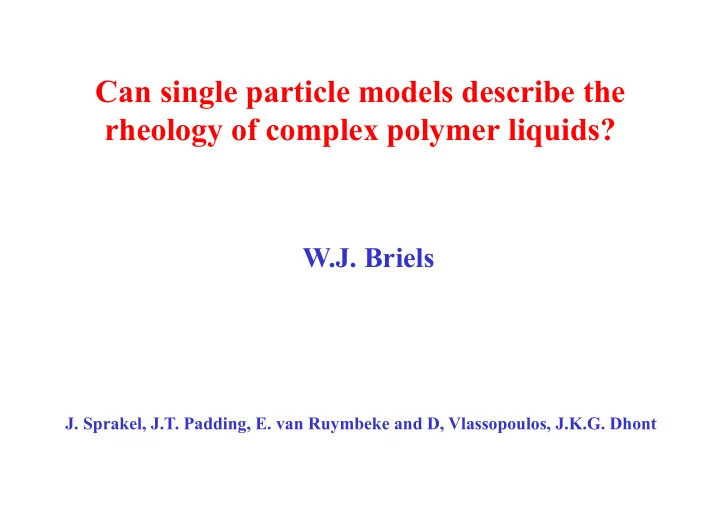

Can single particle models describe the rheology of complex polymer liquids? W.J. Briels J. Sprakel, J.T. Padding, E. van Ruymbeke and D, Vlassopoulos, J.K.G. Dhont
Contents 1. Coarse chains - wormlike micelles 2. Coarse graining 3. Single particle models - star polymers - linear polymers - telechelic polymers
I. Coarse chains
Potential of mean force Simple Brownian dynamics with forces from Calculated using Boltzmann inversion
Entanglements
Viscosities PE
Viscosities PEP No fitting !!
I.a. Wormlike micelles +salt + + + + + + + + surfactant wormlike micelle viscoelastic network
The coarse model Join rods to form breakable chains
Parameters Persistence length Diameter Elastic modulus Scission energy Activation energy
Atomistic simulation calculate persistence length, diameter and elastic modulus
Thou shall not cross bead-bead interactions are short-ranged and soft, and cannot prevent bond crossing
Viscosities 308 K - 348 K, cone-plate 3 10 300 K, simulation 2 10 viscosity [Pa s] 1 10 0 10 -1 10 -2 10 8% EHAC, 2% KCl -3 10 -3 10 -2 10 -1 10 1 10 2 10 3 10 4 10 0 10 10 -1 ] shear rate [s
Viscosities 308 K - 348 K, cone-plate 3 10 298 K, plate-plate 300 K, simulation 2 10 viscosity [Pa s] 1 10 slope -1 0 10 -1 10 slope -2/3 -2 10 8% EHAC, 2% KCl -3 10 -3 10 -2 10 -1 10 1 10 2 10 3 10 4 10 0 10 10 -1 ] shear rate [s
No branching? Twisted PBC: M.P. Allen and A.J. Masters, Mol. Phys. 79 , 277 (1993)
Fusing
Relaxing
No branching ! • Branches cost a lot of free energy • Branches easily slide off one end • Sliding branches are difficult to simulate
II. Coarse graining As coarse as coarse can be
Coarse graining As coarse as coarse can be; a bit more resolution
Coarse graining Transient forces after a compression
Coarse graining A bit less coarse
Two ingredients • Potential of mean force • Friction/memory is due to non equilibrium of the bath W.J. Briels, Soft Matter 5 (2009), 4401
Memory Introduce variables describing the state of the bath: and write i.e. W.J. Briels, Soft Matter 5 (2009), 4401
Dynamics Brownian dynamics in a slow bath W.J. Briels, Soft Matter 5 (2009), 4401
III.a. Star polymers
Potentials and overlap
Transient forces
Linear rheology
Theory for stars (with Jan Dhont) Assuming affine displacements, the stress tensor contains a shear thinning viscous term, a shear curvature term and coupling of diffusion and flow
III.b. Linear polymers
Potentials and overlap • Three body potential • Overlap functions: Gaussians
Polymer melts: C 800 H 1602 Structure factor reproduces right compressibility. ‘Ideal gas’
Potential of mean force Taylor expansion Three body interactions suffice !!
Polymer solutions Polymer solution ‘Worm-like micelles’ Free energy from Flory-Huggins
Chaining
Chaining again
III.c. Telechelic polymers Low density High density Flowers and bridges Flowers
Potential of mean force from SCF calculations from plateau modulus
Parameters This will lead to intelligible values of
Linear rheology Viscosities used to fix
Predicted non linear rheology From upper left to lower right, increasing concentration
Shear banding 1 2 3 1 2 3
Shear banding 20 g/l Open symbols from experiments, everything else from simulations
Banding to fracture
Melt fracture 1 2 2 1
Melt fracture
Structure formation
Non-equilibrium phase diagram
Contents 1. Coarse chains - wormlike micelles 2. Coarse graining 3. Single particle models - star polymers - linear polymers - telechelic polymers
I am done 1. Coarse chains - wormlike micelles 2. Coarse graining 3. Single particle models - star polymers - linear polymers - telechelic polymers
Thank You Brrrrrrrrrrrrrrrrrrrrrrrrrrriels
Simplified theory (1) Langevin equation
Simplified theory (2) Potential of mean force
Coarse model from atomistic simulation Potential of mean Friction force
Scaling with N 1) Characteristic time 2) Equilibrium 3) Friction
Diffusion coefficients of polymer melts
Discussion • tubes conserve (to a large extent) prevalent configuration of centres of mass, as do the transient forces • probabilities of entanglement survival-times decay exponentially; do we need tubes at long times? • to describe elongational flow use dumbbells • types of entanglements, and therefore their relaxation times depend on the distance between polymers.
Model and Dynamics Brownian dynamics in a slow bath number of bridges between and
Model and Dynamics Brownian dynamics in a slow bath number of bridges between and
Coarse graining (dynamics) Eliminate variables: Only useful in case is much faster than , i.e. when no memory occurs
Entanglement free energy
Experiments Open symbols 60 g/l, filled symbols 20 g/l
Recommend
More recommend